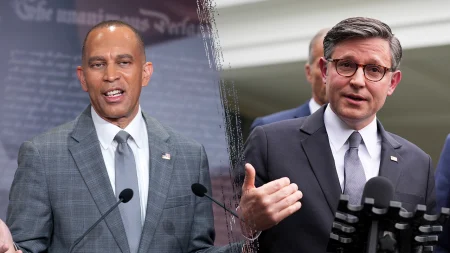Democrats Energized for House Battle After 2025 Victories
In a stunning turn of political fortunes, Democrats are riding high after their convincing victories in the 2025 elections, viewing these wins as a promising indicator for flipping the House in next year’s midterms. The path to regaining control seems tantalizingly close, requiring a net gain of just three seats to reclaim the majority from Republicans who have held the chamber for nearly three years. “We’ll take back the House in 2026,” declared Democratic Congressional Campaign Committee chair Rep. Suzan DelBene with cautious optimism. This potential power shift holds enormous implications for President Donald Trump’s second-term agenda, as a Democratic House could significantly obstruct his legislative priorities. However, Republicans aren’t conceding anything, with National Republican Congressional Committee chair Rep. Richard Hudson focusing on their own magic number: “The only number I’m concerned about is 3. We have three Republicans in seats Kamala Harris carried.” Hudson points to Democrats’ vulnerability, noting they have “thirteen sitting in seats Donald Trump won” and “21 more sitting in seats that Donald Trump barely lost,” suggesting the electoral map favors Republican retention of power.
The political landscape has undergone a remarkable transformation in just one year. While high prices and inflation propelled Trump and Republicans to victory in 2024, allowing them to reclaim the White House and Senate while maintaining House control, Democrats have quickly pivoted to make affordability their rallying cry. This strategy paid dividends in November 2025, when Democrats scored impressive gubernatorial wins in New Jersey and Virginia, along with crucial victories in battleground states like Georgia and Pennsylvania. DelBene attributes this success to voters’ disillusionment with Republican economic policies: “It was clear that when folks are talking about the biggest issues affecting their communities, and right now, affordability, with the rising costs people have seen as a result of the policies put in place by this administration and Republicans in Congress, they rejected that.” Recent polling reinforces this sentiment, with three-quarters of voters viewing the economy negatively and many blaming President Trump for their financial struggles, giving him just a 38% approval rating on economic management.
The cost-of-living crisis has emerged as the Democrats’ most potent weapon against Republican incumbents. DelBene hammers home this point, stating, “Affordability is still the number one issue for families. Housing, food, health care, child care, energy costs all going up directly as a result of policies put in place by Republicans in Congress and Donald Trump. And they promised to lower costs on day one.” She characterizes this as “a big broken promise” that voters are feeling acutely in their daily lives. The DCCC has strategically linked vulnerable House Republicans to Trump’s policies, particularly targeting tariffs that have “raised costs for families across the country” and efforts to “gut health care.” DelBene claims Republican priorities have consistently favored “the wealthy and the well-connected” while “hurting working families across the country,” a message that appears to be resonating with voters frustrated by persistent economic pressures despite promises of relief.
Republicans, however, are pushing back against the Democratic narrative and downplaying the significance of the 2025 election results. Hudson characterizes these Democratic victories as occurring primarily in “Democrat states” rather than representing a national trend. Still, he acknowledges the elections served as a “wake-up call” for Republican voters, noting, “I think our big takeaway as Republicans is the Democrats were energized. They turned out at record levels. Republicans turned out in normal levels.” This turnout disparity represents a significant challenge for Republicans heading into 2026, particularly given that many of Trump’s most ardent MAGA supporters are considered “low-propensity voters” who typically only cast ballots when Trump himself is on the ticket. Hudson recognizes this vulnerability, saying, “I don’t need all of them to show up, but I need some of them,” and advocating for Trump to be “out there on the trail” during the midterms to energize the base.
The economic debate continues to evolve as both parties stake their claims to being the true champions of financial relief for American families. Hudson deflects criticism of current economic conditions by blaming the previous administration: “There are challenges out there with the economy, because Biden broke it, and House Republicans, working with President Trump, are going to fix it.” He expresses confidence that by tax season, “a lot of families are going to be really happy to see they’ve got a lot more take-home pay, and that’s because of Donald Trump and House Republicans.” This argument attempts to shift voters’ focus toward future economic improvements rather than present difficulties, while simultaneously reinforcing the connection between House Republicans and Trump’s agenda – a connection Democrats are also emphasizing, but for very different reasons.
As the battle lines for the 2026 midterms take shape, both parties recognize the extraordinary stakes involved. For Democrats, reclaiming the House would provide a crucial check on Trump’s second-term agenda and potentially allow them to advance their own priorities on affordability, healthcare, and economic equity. For Republicans, maintaining their narrow majority is essential for implementing Trump’s vision and preventing Democratic obstruction. Recent polling gives Democrats an edge, but as DelBene cautions, “we take nothing for granted.” Meanwhile, Hudson remains optimistic that Republicans will actually “grow our House majority.” With control potentially hinging on just a handful of competitive districts, both parties are already mobilizing resources, refining messages, and preparing for what promises to be an intensely fought campaign centered on kitchen-table economic issues. For voters across America struggling with persistent financial pressures, the outcome will determine which party gets the opportunity to deliver on their promises of economic relief and prosperity.















